|
Tue 20 Jul 2010
Visit ot Bank Hall, Bretherton. |
|
Heavy rain
didn’t deter members of Chorley Historical and Archaeological
Society from a conducted tour of Bank Hall and the grounds. The
tour was conducted by Lionel Taylor of the Bank Hall Group who
gave us a journey through time to explain the hall’s history and
also their plans for the future. The main unexpected bonus was
the tour of the extensive grounds and its many plant and trees.
Probably the most fascinating was Lancashire’s oldest yew which
dates back to about 1580. There are a total of 100 yews in the
grounds. Another gem was the remaining mechanism of the clock
which was originally housed in the clock tower. The cogs and
wheels were manufactured by John Alker during the 1831
restoration. After the tour our secretary, Peter Robinson,
presented a £250 cheque to Lionel for the ‘Moment in Time’
project which will restore the roman numerals on the Hall’s
Clock face. So our society will have funded the numeral II. BH. |
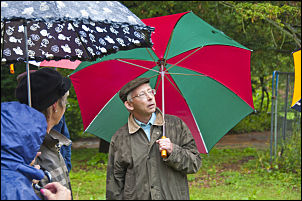
Lionel Taylor |
The following text was supplied by
our secretary Peter Robinson
Visit to Bank Hall, Bretherton
As a result of Bank Hall Action Group’s (BHAG) visit to the
society in June the society took up their offer of a guided
visit of the hall.
It took place on the very wet evening of Tuesday 20 July.
Despite the heavy rain 16 sensibly dressed members and friends
made the short journey over to Bretherton. Lionel Taylor,
Secretary of BHAG, was there to meet everyone and was helped
along the way by Graham, a fellow BHAG member.
For safety and security reasons Bank Hall, or what remains of
it, is cordoned off by a high wire perimeter fence and Lionel
started his 2 hour guided tour from its north side. What exists
now includes its four walls and much of the imposing but
precarious looking clock tower.
Lionel pointed out particular aspects of the hall’s structure
and explained it was built in 1608 but underwent a restoration
in 1832. As mentioned in June plans are before Chorley Borough
Council to restore Bank Hall. They include provision for private
apartments and also public access. The estimated cost of this
restoration is set at £6m, which gives an idea of the scale of
work that is required.
His guided tour also included a walk around the grounds of Bank
Hall, in particular the woodland area. Voluntary work in the
grounds continues to be done by BHAG members, which aims to
restore the grounds to something like their best. Several
particularly interesting tree species include the oldest yew in
Lancashire. It is dated to be older than Bank Hall itself at
around the late 1500’s. Another tree is the coast redwood,
native to north America, and is one of only 2 in Britain. This
one is unusual by the fact the original tree fell to the ground
years ago and now a line of ‘new’ trees rise from its trunk.
Not surprisingly there is an abundance of bird life and Graham
described the various species found there that included tree
creepers, sparrow hawks, tawny and barn owls.
The evening concluded with the society presenting Lionel with a
cheque for £250 towards BHAG’s ‘Moment in Time Project’. This
donation will go towards the restoration of the clock from the
tower. Lionel, in turn, presented the society with a certificate
to say the roman numeral II on the clock face was as a result of
our donation.
So thanks to both Lionel and Graham for giving us such an
interesting insight into the colourful history and stories of
Bank Hall. As the darkness rapidly closed in we left Bank Hall
to its thoroughly wet ghosts.
P Robinson. |
|
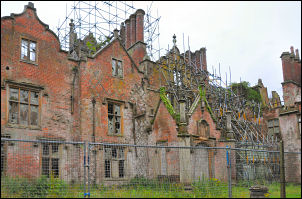
This evenings gloomy view of Bank Hall in the rain |

Bank Hall in 1977 |
|

Trying to get some shelter under Lancashire's oldest
Yew tree.
|
Yew is the wood of
choice for longbow making. Longbows have been
used for hunting and warfare. A famous example
being the English longbow during the Middle
Ages. The bows are constructed so that the
heartwood of yew is on the inside of the bow
while the sapwood is on the outside. This takes
advantage of the natural properties of yew wood
since the heartwood resists compression while
the sapwood resists stretching. |
|
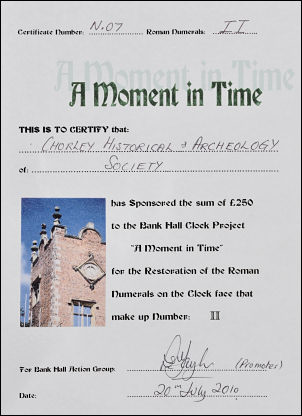
our 'Moment in Time' certificate to acknowledge £250
towards the numeral II |
|

Bank Hall c1860 (see 2010 view below) |
|
|
 |
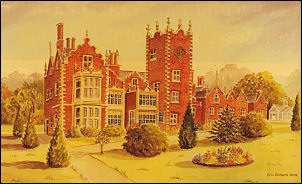
a delightful view of Bank Hall
painted by Eric Vickers in 2002 |
|

the garden wall, which was originally heated! |
|
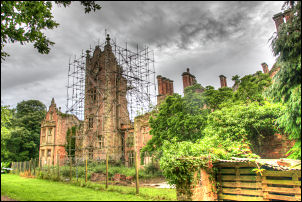
Stormy skies over Bank Hall |

The remaining clock mechanism from 1832 |
|
|
|